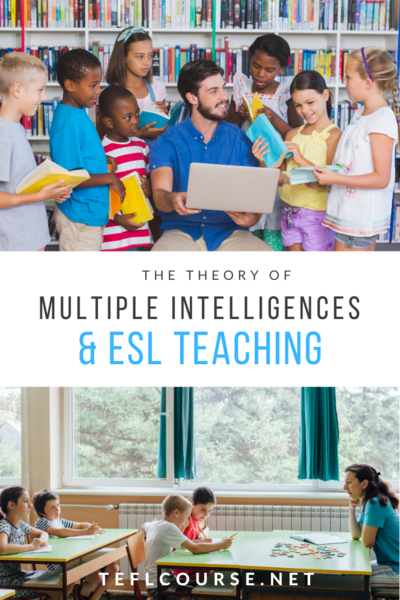The Theory of Multiple Intelligences and ESL Teaching

The theory of multiple intelligences, suggested by an American developmental psychologist Howard Gardner in 1983, considers human intelligence, not as a dominant single ability for perceiving information, but the one in a variety of specific conditions.
Table of Contents
Multiple Intelligences and ESL
Do you want to teach English abroad? Take a TEFL course!
This post was written by our TEFL certification graduate Olha K. Please note that this blog post might not necessarily represent the beliefs or opinions of ITTT.
The Theory Outline
This approach differentiates human intelligence into specific interacting modalities, rather than understanding it as the one dominated by a single general ability. The author thought that this theory would allow us to be able to teach different people more efficiently. Gardner claims that there is a wide range of cognitive abilities and there is only a very weak correlation between them. For example, the theory predicts that a child who can learn something easily, for example, some English songs or grammar rules, is not necessarily smarter than a child who has great difficulty learning the same process.
The author offered this approach in his book Frames of Mind: The Theory of Multiple Intelligences. Gardner suggested that people have seven main kinds of mental abilities (intelligence):
- musical-rhythmic (sensitivity to sounds and music)
- visual-spatial (the ability to visualize)
- verbal-linguistic (facility with learning words and languages)
- logical-mathematical (facility with understanding abstractions, reasoning, numbers, and critical thinking)
- bodily-kinesthetic (connected to different physical activities in general)
- interpersonal (sensitivity to others' feelings)
- intrapersonal (able to predict one's reactions or emotions, the ability of self-discipline, self-understanding, and self-esteem).

Also Read: How do I get a job teaching English in China?
The Applicability
The use of the basic principles of the theory of multiple intelligence in the educational process seems to be one of the best options for organizing an individualized learning process, as students become active subjects of educational activity and learn certain knowledge and skills through direct perceptions. A teacher should be able to work simultaneously with different students with different initial levels of knowledge, different mentality, different attitudes towards learning, building up a unique learning path for a particular student, taking into account the characteristics of his intellectual organization.
Options for applying the Gardner theory in the lessons can be different, but the main principle is important: the educational process should be structured in such a way as to enable the children to gain experience that would require the involvement of different types of intelligence.
Also Read: Do I need a degree to teach English abroad?
Multiple Intelligences and ESL
The process of teaching a foreign language is built mainly based on linguistic intelligence. To include other types of intelligence in the work there can be introduced to a variety of activities for English classes:
Development of verbal-linguistic intelligence: word games aimed at enriching and activating vocabulary, memorizing new words in different ways, working with metaphors, phraseology, comparisons; retelling, dialogues, discussions, stories, jokes.
Development of logical-mathematical intelligence: word order in a sentence, classifying objects, words, establishing a sequence of information, lists, highlighting keywords in a text, making words (by letter, syllables), logical games, tasks involving numbers, solving various problems, drawing up schemes, comparing animals, people, cultures and traditions.

Developing visual-spatial intelligence: projects related to art (creating portraits of a family, friend, image of a favorite toy), graphic organization of a lesson (tables, graphics that students can create), the use of color, visual presentations (videos, slides, photographs), video projects creating a route on the map and explaining the choice of this route.Developing musical intelligence: the creation of rhythmic texts containing information on the topic, rules, verses; tongue twister, musical presentations.
Developing kinesthetic intelligence: instant response cards: active games, pantomimes.
Development of interpersonal intelligence: working in pairs, team games, discussion, research, exchange of opinions, voting, group projects, dialogues.
Also Read: 4 Essential Tools For Teaching ESL Online
Choice of Activities
Activities developing intrapersonal intelligence: an independent study of the task, a story about student's family, a description of places where students feel free and happy, evaluating their results, individual projects, self-correction, writing poems and stories, expressing personal impressions, opinions.
For the successful implementation of the theory of multiple intelligence in teaching English, it is recommended to maintain interest and increase the motivation of the students learning a foreign language, always take into account the psychological characteristics of students in the learning process, renew and enrich the learning environment with a wide variety of new objects in order to develop their curiosity, create conditions for the creative activity.
Do you want to teach English abroad? Take a TEFL course!
In conclusion, it should be noted that taking into account the intellectual characteristics of students during classes, the teacher also develops various skills. He begins to perceive his students from at least seven new positions. Planning such lessons requires ingenuity, so there are growth and development of the creative potential of the teacher himself. As a result, the introduction of the main principles of Howard Gardner's theory into the practice of teaching English helps not only to improve the results of language learning but also improves the quality of teaching.
Thus, the use of the basic principles of the theory of multiple intelligence in the educational process seems to be one of the best options for organizing individualized instruction in English classes, as it provides not only effective teaching and mastering a foreign language, but also the comprehensive intellectual development of each student.
Apply now & get certified to teach english abroad!
Speak with an ITTT advisor today to put together your personal plan for teaching English abroad.
Send us an email or call us toll-free at 1-800-490-0531 to speak with an ITTT advisor today.
Related Articles:
- The How-To Guide to Prepare for Your Teaching Job Abroad
- 7 Misconceptions about TEFL Uncovered
- Top Tips for Taking an Online TEFL Course
- Guide to Writing a TEFL Resume That Will Get You Hired
- Top Tips for Teaching English in Europe
- TEFL Breakdown - What Subjects Will Your TEFL Course Cover?




